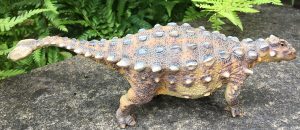Complicated Nasal Passages Helped Keep Ankylosaurs Cool
Animals have a number of ways of controlling their body temperatures and cooling down. Some warm-blooded animals like kangaroos and antelopes seek shade during the heat of the day. Elephants cover themselves with mud or take a cooling dip. Dogs pant and humans sweat, but how did the heavily armoured dinosaurs keep cool? These “living tanks” with their huge, armoured bodies could have been in danger of overheating as they wandered around in the Mesozoic.
Ankylosaurs with Air Conditioning
A new paper suggests that their complicated nasal passages not only would have helped these animals with their sense of smell, but they would have acted as very efficient heat transfers.
Ankylosaurids with Built in Air Conditioning
Picture credit: Everything Dinosaur
A team of scientists based at Ohio University used CAT scans of ankylosaurid cranial material to map the anatomy of the complex nasal passages in two different North American ankylosaur species. The team then modelled the air flow in three dimensions using a computer programme that interpreted the CAT scan data. Palaeontologist Jason Bourke, one of the authors of the scientific paper stated that the complex nasal passages would have given the inhaled air more time to warm up to body temperature by drawing heat way from blood vessels in the nasal cavity. This would have helped cool the blood and in turn this would have cooled vital organs such as the brain.
Brain Size in Ankylosaurids
The brain of even the largest ankylosaurids was extremely small when compared to their body size. The dinosaur experts at Everything Dinosaur regularly compare the brain of a large ankylosaur such as Euoplocephalus tutus to the size of a child’s fist. The nasal passages would have helped to keep the brain in its heavily armoured skull cool and stable.
Mammals and birds use scroll-shaped bones called conchae, otherwise known as turbinates to warm air that is breathed in, but the armoured dinosaurs seem to have achieved the same result with a completely different anatomical configuration.
Transferring Heat Whilst Breathing
Commenting on the study, Jason Bourke stated:
“There are two ways that animal noses transfer heat while breathing. One is to pack a bunch of conchae into the air field, like most mammals and birds do, it is spatially efficient. The other option is to what lizards and crocodiles do and simply make the nasal airway much longer. Ankylosaurs seem to have taken this second approach to the extreme.”
Doctor Lawrence Witmer (Ohio University), who was also involved in this research explained:
“Our team discovered these “crazy-straw” airways several years ago, but only recently have we been able to scientifically test hypotheses on how they functioned. By simulating airflow through these noses, we found that these stretched airways were effective heat exchangers. They would have allowed these multi-tonne beasts to keep their multi-ounce brains from overheating.”
Complext Nasal Passages
Ohio University researchers had previously studied the complex nasal passages of another group of ornithischian dinosaurs – the pachycephalosaurs.
To read this earlier article: Nosing Around Pachycephalosaurs.
Just like noses in humans, (Homo sapiens) ankylosaurid noses are likely to have served more than one function. As the complex nasal passages helped condition the air that was breathed in and out, water may have been removed from exhaled breath helping these dinosaurs to retain water, important when you live in arid environments. In addition, the convoluted passageways may have added resonance to the low-pitched sounds this dinosaur made. The nose could have amplified these sounds acting as a resonator, making the noises made by ankylosaurs heard over greater distances.
A Model of an Ankylosaurus
Picture credit: Everything Dinosaur
The model (above) is “Sede” the Ankylosaurus from PNSO. To view the range of PNSO prehistoric animal models and figures in stock: PNSO Age of Dinosaurs.








Leave A Comment